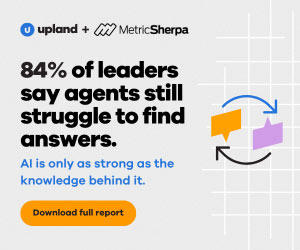Our panel of experts give their ideas for how to help boost long-term productivity in the contact centre.
1. Schedule Training for Convenient Times
Focus on intrinsic motivators to keep employees engaged by prioritising training and supporting career progression within the organisation.
The majority of contact centres fall into the trap of perceiving training and coaching as an ad hoc task. Avoid making this mistake by using workforce management tools to proactively schedule in training time during expected off-peak periods.

Scott Budding
By scheduling training at convenient times, the contact centre will be able to meet its staffing and business needs, while demonstrating a commitment to advisor development, by ensuring training does indeed happen.
Moreover, when looking at how best to coach advisors, the contact centre should also consider giving them ownership of their own development, by allowing them access to their calls, encouraging them to reflect and come up with ways to improve their performance.
Thanks to Scott Budding at Business Systems.
2. Allow Trusted Advisors to Work from Home
Advisors are increasingly dealing with more complex enquiries, and of course, playing an increasingly valuable role in the buying process. One way to show them that they are valued is to provide flexible or remote working options.
Allowing advisors to work from the comfort of their homes will help them achieve a better work–life balance, which is likely to improve their motivation and ultimately make them more productive.
A cloud-based system can make this easy to implement without affecting operations or how customers are managed.
3. Properly Manage Multichannel
A properly managed multichannel contact centre is one of the best tools that can be used to ensure advisors are more productive, and it will result in happier customers too.
By giving the contact centre team different options to connect with customers, advisors get some variety in their job, which can keep motivation high. This helps to minimise the repetitive nature of the job, as advisors can be responding to emails, or be on the phone, and solve a problem in real time with IM chat in the same day.
With the right skills, and with the right workload, being able to juggle multiple channels can really boost productivity and motivation.
4. Be Attentive with Quality Monitoring Tools
Recording calls for quality control can help boost productivity, as coaches can listen in to give advisors positive feedback where it is merited, as well as constructive and supportive criticism. That way, the contact centre can help advisors to develop their skills and career while keeping the team motivated.
It may even be worth letting advisors listen back to their own calls to get a better perspective on how the conversation developed. This way, each individual will feel like they are part of the feedback process and in charge of their own career development.
5. Empower Advisors
Too often frontline customer service representatives just don’t have enough information, and are often not given the responsibility that they need, to resolve customer queries first time.

Enda Kenneally
Advisor productivity can be improved and repeat calls avoided by introducing metrics such as First Contact Resolution (FCR) and giving advisors the training and technology tools they need to create satisfied customers.
So, ask yourself: do your contact centre workflows and scripts support your advisors to make their interactions as natural and human as possible, or are they inflexible, robotic and frustrating for both parties?
Thanks to Enda Kenneally at West Unified Communications
[Here are: 5 Ways to Empower Your Agents]
6. Automate Channel Shifts
Make automated channel shifts part of the daily operation for long-term productivity gains, but control it carefully to ensure a good customer experience.
One way to utilise all channels effectively and maximise staff resources is to use channel shifts during peaks and troughs in contact volumes. For example, when the inbound contact centre is quieter, advisors could be swapped onto another channel, perhaps from voice to email, for instance.

Ken Reid
Remember, channel shifts can also be used to ‘meet’ customers on their chosen channel and take them to wherever is most appropriate.
For example, the contact centre could play a message in the customer queue which directs callers to the company website to self-serve. This will reduce queues and ensure that staff are only dealing with contacts that can’t be helped using self-service.
Thanks to Ken Reid at Rostvm Solutions
7. Measure Call Duration by Advisor, Team and Procedure
Measuring call durations by advisor, team and procedure can help an organisation identify quality or service issues.
Peaks and troughs in performance could be due to long holds, periods of silence, lengthy troubleshooting, slow transfer procedures, faulty IVR/ACD routings, sluggish connections, insufficient knowledge bases, inadequate training or excessive after-call work (ACW).
All of these impact an advisor’s Average Handle Time (AHT) and, as a result, reduce the time spent on more productive activities, such as making more calls. Understanding where breakdowns occur is therefore critical to reducing AHT.
However, these times should be measured behind the scenes and should not be set as an advisor target, as quality service should be prioritised.
8. Use Analytics to Identify What Long-Term Improvements Can Be Made and Where
If you want to make sustained improvements to advisor efficiency then you first need to identify where improvements can be made. The intelligent use of interaction analytics to measure and score 100% of advisors’ interactions is one way of identifying where these sustainable wins exist.
For example, advanced acoustic analysis can identify long periods of silence on the call. If a contact centre only listens to 1-3% of its advisors’ calls, the likelihood of you realising that it may be a wider trend will be much lower.
By employing interaction analytics, the contact centre could also continuously measure its advisors’ performance to achieve sustainable behavioural changes. This is because the technology can be used to expose any issues in near or real time through dashboards and reports.
9. Create a Personalised Scorecard for Self-Learning
A personalised scorecard makes it possible for an advisor to be reminded of the need to improve in certain areas.

Frank Sherlock
For example, before a shift starts, an advisor may decide to focus on improving empathy and then measure their own improvement by reviewing their scorecard at the end of the shift. This is a good example of self-evaluation and sustainable improvement in action.
An improved scorecard can also be developed through interaction analytics, using insight provided by the personal dashboard and daily discussions with the supervisor or coach, to reinforce the improvements that have been made.
Thanks to Frank Sherlock at CallMiner
10. Use a Cloud Platform and Deploy Microservice Architecture
All data produced in the contact centre should be stored in one place, ideally in a cloud platform. Deploying this kind of platform means contact centre staff don’t have to spend valuable time on data entry at the end of each day. It also allows for easy access and analysis of data, allowing for further improvements of workforce productivity.
Where possible, microservice architecture should also be deployed when cloud solutions are installed. This kind of architecture minimises dependence on a single system and means that each contact centre function runs on an individual basis. If one goes down, the rest don’t suffer.
This allows advisors to carry on with most aspects of their work and the impact on productivity in the contact centre and customer experience, is lowered.
11. Free up Advisor Time by Implementing Collaboration and IVR Solutions

David Paulding
Collaboration solutions can greatly improve long-term productivity in the contact centre. If an advisor doesn’t have the solution to a customer’s query, they can quickly connect with a colleague who can. This can save lengthy calls and repeated interactions with the customer.
Advanced IVR solutions also free up advisors’ time. They map out the most common customer journeys, allowing them to find answers to their questions quickly and easily. This gives advisors more time to spend with customers who require more hands-on assistance.
Thanks to David Paulding at Genesys
12. Ensure Contact Centre Solutions Are Linked to the CRM
Productivity will rise if contact centre solutions link seamlessly with other business directories and critical customer relationship management systems (CRM).
This integration presents advisors with essential caller information and a single view of the customer to deliver highly personalised customer interactions.
Integration with CRM removes the need for advisors to switch between applications and manually transfer data from one application to another. Making the right connections instantly presents advisors with important customer records containing contact information, activity history and case notes.
By implementing a cloud-based contact centre solution, integration is straightforward – everything is set up through a secure internet connection without the need for complex or hardware installation, reducing the number of potential points for failure.
13. Give Advisors the Tools They Need

Colin Hay
- Route inbound enquiries automatically to ensure they are answered quickly by the first available, most-skilled advisor
- Automate routine tasks otherwise carried out by advisors by providing self-service options
- Enable advisors to transfer calls quickly to enhance customer experience and speed up query resolution
- Make sure advisors have an intuitive and straightforward interface at their fingertips
Thanks to Colin Hay at Puzzel
14. Introduce Virtual Assistants to Handle Menial Duties
Menial jobs do nothing for staff productivity, so the introduction of virtual assistants and online chatbots instantly helps to remove the hassle of dealing with straightforward customer requests.

Colin Whelan
Using Artificial Intelligence (AI) in the contact centre itself removes some of the more stringent and formulaic processes associated with administrative tasks, such as booking holiday time, extra hours or sick days.
By outsourcing these tasks to intelligence software, productivity increases are much more likely to happen as advisors are freed up to work with more complicated cases that need the human touch.
Thanks to Colin Whelan at Aspect
15. Optimise the Work–Life Balance
As advisors frequently handle a myriad of complex conversations throughout a working day, reducing stress is critical to an uplift in performance and output.
Key to this are cloud-based applications, from unified communications to CRM. These applications are making workforces more agile and flexible. As these apps are increasingly integrated into softphones, headsets and other collaboration devices, advisors will be provided with the flexibility to work from anywhere.
In doing so, the work–life balance of advisors will improve. This will translate into more output in less time and actively address labour attribution, an ongoing challenge for the UK contact centre industry.
16. Give Advisors the Freedom to Take a Call on the Move
Up to 20% of contact centre advisors’ time can be spent away from their desks. This means they need a flexible headset solution that allows them to take calls on the move.

Nigel Dunn
Investment in wireless headsets can help to solve some of the day-to-day challenges faced by call-centric workers.
If an advisor needs to retrieve important documents or speak to a colleague at the other end of the office to help solve a customer query, they can do so in real time without having to call the customer back.
When operations become seamless and disruption is reduced, worker productivity improves.
Thanks to Nigel Dunn at Jabra
17. Find and Fix Broken Processes
Sluggish processes that are neither lean nor innovative don’t do any favours to either the contact centre or the customer. Give the team leaders, operation managers and IT teams (including the UC and Network “guys”) time to audit processes and an opportunity to research other ways of doing things. Give them an open forum to present their ideas. Don’t wait until disaster strikes or budgets are cut before you innovate.

Mike Burke
A Nemertes Research report in 2017 found that IT leaders delay analysis of helpful UCC monitoring and management tools until they run into problems.
Keep a hawk-eye view on your technology and have red flags and alerts that highlight when thresholds are breached, so you can keep systems up through other means. This relates closely to the point about proactive rather than reactive, which has a massive impact on your productivity long term.
Thanks to Mike Burke at IR
18. Introduce Self-Service Options for Simple Queries

Tim Pickard
If a customer wants to confirm that a package has been shipped or check a balance on an account, it can be useful to self-serve and avoid the need to speak to an advisor.
Customers get the information they’re looking for and their experience is a more efficient and personalised one, while advisors are freed up and can spend more time focusing on more complex enquiries or handling new business.
Thanks to Tim Pickard at NewVoiceMedia
[For more on this subject, read our article: Implementing Self-Service – Don’t Forget the Customer!]
19. Perfect Quality Monitoring

Phillip Reynolds
Monitoring of calls by supervisors is the obvious go-to solution, but, in many cases, the contact centre needs more than that. Quality measurement features and call recording solutions will provide a host of features for call assessment and advisor feedback and motivation.
Quality scores are the most obvious form of measuring call quality, but these need to be calibrated, not only to make the process fair to advisors but to provide consistency across the business. This will reveal how monitoring has improved productivity in the long term.
Thanks to Phillip Reynolds at Oak Innovation
[For more on this topic, visit our page: How to Calibrate Quality Scores]
20. Develop Personalised Training and Support Programmes
Supervisors would enjoy a solution that takes individual advisors’ metrics, attributes and preferences into consideration to develop a bespoke training and support programme.

Yohai West
Using AI-generated insights, this solution would really put the ‘super’ back into supervisor and enable them to focus their limited time on who and what to coach.
The system could also offload the burden by keeping all the advisors in less dire need on track by assigning tailored engaging self-service coaching and trivia.
This adaptive personalisation is the key to employee engagement and, ultimately, improved customer satisfaction.
Thanks to Yohai West at NICE
21. Make Sure Incentives Are Aligned with Overall Business Goals
It’s important that any advisor incentive scheme is fully aligned to the organisation’s end goals. That’s because incentive schemes are typically intended to drive real-time changes in behaviour.
The danger is advisors can become fixated on getting a certain number of calls completed in a day, for example, to meet a stipulated target.
This can be a real problem if the organisation is primarily focused on repeat business and customer retention and therefore sees having a strong net promoter score as an excellent metric and key performance indicator (KPI), but at the contact centre level, advisors are being incentivised based on the number of calls processed.
The business has effectively set up two measurements that are working against each other. So our advice to companies is to tread carefully around incentive schemes. It is very easy to set them up, but it is key, in everything that the contact centre does, to keep the ultimate business objectives front and centre, at all times.
22. Provide Quality Management so Advisors Know Where They Stand
Make sure the tools advisors are given have visibility of scorecards and real-time dashboards which allow them to see at a glance how productive they have been.
You may, for example, have answered 30 phone calls and 5 emails during the day, while your colleagues had on average answered 35 phone calls and 10 emails.
It’s not purely a question of quantity, of course, and the ability to also view end-of-call wrap-up and satisfaction surveys gives advisors the opportunity to see how effectively they have addressed customer queries and resolved their problems.
It is also about striking the right balance between quantity and quality and understanding that the true measure of productivity is not just about getting through a greater volume of work, but just as much about the value that that work delivers.
23. Focus on Workforce Management Optimisation
Contact centres and end customers both suffer when workforce management or scheduling goes wrong and businesses are suddenly hit by a deluge of calls with very few advisors in place to deal with them. It should not happen, of course, but the reality is that it often does.
Better workforce management is clearly required, but this is a complex requirement for businesses. Yet in today’s multichannel environment, it’s not as simple as the organisation just saying ‘We need 100 people to answer the phone on a Monday morning’.

Jeremy Payne
Instead, it’s a question of aligning all the channels and the different times of the day with the resource, the contact centre has to make sure that its customers always receive a consistent level of service across all channels. That way, both customers and advisors will be happier.
Also, with an optimal number of advisors in place, the contact centre can guard against low productivity, which comes from having too many advisors to handle too few contacts.
Thanks to Jeremy Payne at Enghouse Interactive
For more insights into contact centre productivity, read our article:
- How to Calculate Productivity in the Contact Centre
- 4 Customer Service Objectives That Will Improve Productivity and Customer Experience
- 30 Strategies for Improving Agent Productivity
Author: Charlie Mitchell
Published On: 28th Jun 2017 - Last modified: 8th Sep 2025
Read more about - Customer Service Strategy, Alvaria, Business Systems, CallMiner, Colin Hay, Colin Whelan, Enghouse Interactive, Genesys, Intrado, Jabra, Jeremy Payne, Ken Reid, NiCE, Productivity, Puzzel, Rostrvm, Scott Budding, Service Strategy, Vonage






































